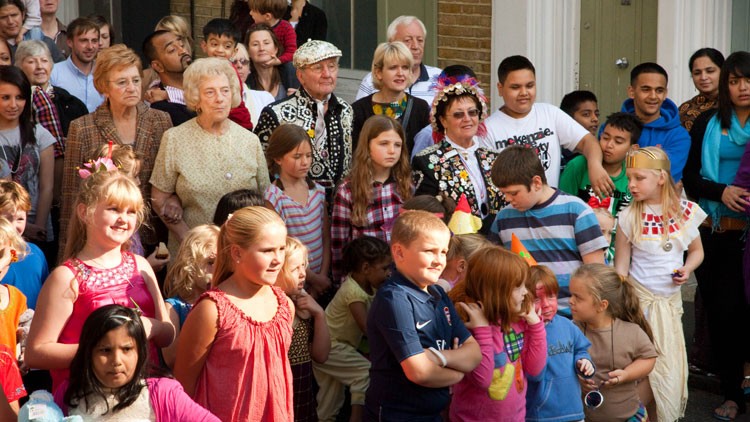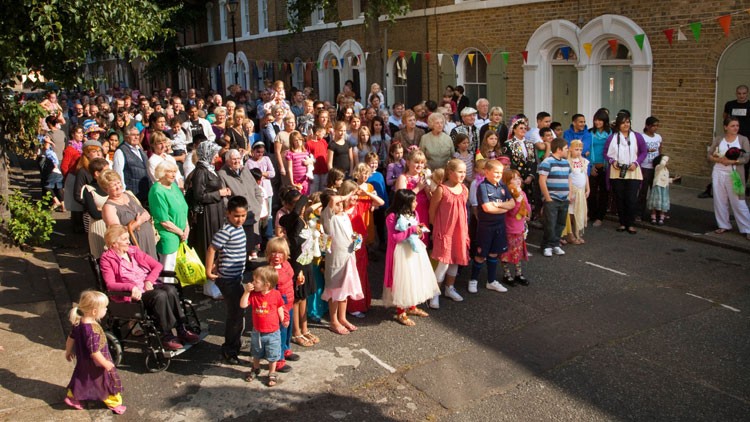Celebration (Cyprus Street)
Steven Bode
FVU Director Steven Bode reflects on the making of Celebration (Cyprus Street) as well as its relevance for today.
Projects
This text was written in 2019, in advance of the tenth anniversary of the staging of Melanie Manchot’s Celebration (Cyprus Street) at Whitechapel Gallery from 13 January to 14 March 2010. Ten years on from that date, Cyprus Street, like so many streets in Britain and across the world, has been through an unforeseen experience of lockdown, from which it is slowly starting to emerge. Manchot’s film, and its uplifting group portrait of the residents of the street, is both a joyful reminder of better times and a poignant image of hope for the future.
It is exactly ten years, at the time of writing, since Melanie Manchot began what is still one of her most substantial film projects, Celebration (Cyprus Street). This ten-year anniversary may be little more than a minor footnote in the larger scheme of things, or at least when compared to the centenary or golden jubilee festivities that provide some of the inspiration for Manchot’s film itself, but the landmark is a significant moment, nonetheless. An anniversary is always a cause for congratulation, but the occasion also often merits a pause for reflection – a chance to assert a feeling of continuity over time, and measure the changes that time brings in its wake.
Celebration (Cyprus Street) originated from a research project by Manchot that was part of a series of off-site initiatives run by Whitechapel Art Gallery during the period when the venue was closed for extension and refurbishment in 2009. In an empty shop on nearby Toynbee Street, Manchot opened a drop-in space where members of the public were encouraged to share memories and swap stories of street celebrations and other festivities that had taken place in the East End. The numerous photographs and souvenirs that people showed her added to a rich seam of material she had already accumulated from museum collections, film libraries and other historical archives. Street parties had long had an important place in this area of London, which had traditionally been a magnet for newcomer, migrant communities. National events such as royal jubilees or coronations often brought individuals from different cultures and backgrounds together, consolidating a sense of neighbourhood and belonging. What was evident from the conversations Manchot started to have with the older visitors that quickly and eagerly engaged with her project was a deep nostalgia for the warmth and solidarity of an earlier era: when people had more time, and more time for each other.
The frequency of these conversations led Manchot to wonder whether there would be a similar appetite for an equivalent local get-together, and prompted her to look for sites where street parties had been thrown to see if there was contemporary interest in reviving the tradition. She had recently completed a series of highly composed photo-portraits of Moscow residents at popular tourist attractions across the city that played on the legacies of Soviet iconography and its significance in the lexicon of photography. Manchot was equally keen for her London project to gesture to a comparably historical photographic blueprint, but just as concerned that her protagonists had agency in the situation, and were not just actors in a staged recreation or pastiche. For that reason, she left decisions about where and when a future street event might happen in the hands of local residents. One of several parallel discussions drew her to Cyprus Street in Bethnal Green, where an enthusiastic group were forging ahead with plans for an event in the autumn. Although she helped to organise it, Manchot did not attempt to lead it – confining herself to how she might want to film it: with a collective group portrait of all the residents as a centrepiece. After gaining the support of Film and Video Umbrella, who committed to produce the film, she inked a date in her diary for Saturday 26th September 2009.

Celebration (Cyprus Street) is a single, continuous take of 10 minutes, 20 seconds, recorded on a single roll of 35mm film. It does not proceed from a standing start but begins, mid-motion, as the camera glides around a corner to reveal a long, straight street stretching ahead. A crowd is congregating in the middle-distance, and the camera moves towards it, as do one or two individuals who cross from the pavement on to the road. Outside some of the street’s neatly uniform terraced houses, tables and chairs have been set up by the front door. We start to hear the sounds of conversation, of merriment, of music – all of which grow louder and stronger the further up the street we go. The painted sign on the road says to go SLOW, and the camera vehicle (the camera seems to be mounted on some kind of vehicle) defaults to walking pace; on the shoulder of ambling pedestrians and darting, zigzagging kids. After a minute or two, the perspective starts to narrow, as more and more people converge. A child in a lemon yellow outfit pulls an empty trolley behind her as she walks, alongside what may well be her sister riding a scooter. Another child carries a toddler aloft, and a trio of pensioners walk arm in arm, with another young girl at their side.
All of a sudden, the assembling crowd starts to settle on one spot, and into the informal but accustomed order of an impromptu yet familiar group: children towards the front, adults at the back or to the side. A couple of hundred individuals strong, the line-up goes seven or eight rows deep. The camera rises – to size up the shot, and fit everyone in. There is a hiatus: children fidget; some wander out of frame, to hurriedly dash back in. As we watch this unfolding, in real time, on film, it is clear is how much Manchot is at pains to foreground the ritual of posing for a photograph – an action that was so much more of a performance in the medium’s early years, where the need for elaborate, protracted preparation was often followed by a correspondingly long, extended exposure. There is a hush: a metaphorical intake of breath. The subjects fix their expressions, and go on holding their position, for a long-drawn-out two minutes. As time slows down, little details come into focus: the exuberant diversity of the children’s party costumes; the way in which the outfits of the street’s Pearly King and Queen echo the patterns of the headscarves of the two women standing next to them. Everyone continues to hold their pose, until some of the children break ranks and, in an outpouring of chatter and laughter, the group breaks apart.
The film has not finished, even if the moment of the portrait has passed. As the crowd disperses, the camera vehicle, once again, moves on. The sound of music once more becomes audible. People drift away up the street, as the camera follows, eventually reaching a junction, where the film, like the street, comes to a close.
*************************
As I step back into Cyprus Street, ten years on, it doesn’t present a markedly different face to the one it offers in Manchot’s film. Many of the houses’ distinctively coloured doors and shutters have had a new lick of paint; the pub sign still stands even as all traces of the pub itself continue to recede. Location scouts routinely criss-cross London in search of similar pockets of generic order and calm. Estate agents, too, would probably commend its quiet, well-preserved, neighbourly ambience. In its mix of private ownership and social housing, the street almost certainly scores highly on the capital’s average demographic metrics. Cyprus Street is not a conservation area – not yet. But you get the feeling there is a consensus among the residents that it would be nice to keep things more or less as they are.
Cyprus Street may not have changed all that conspicuously but the world has changed greatly around it. It is refreshing but disconcerting to note that over the entire ten minutes of Manchot’s film, no-one is seen looking at or making a call on a mobile phone – something inconceivable in 2019. Perhaps the most pervasive effect of the smartphone over the last decade goes beyond its ubiquity as a handheld telecommunications device. Hooked up to the internet and social media, the smartphone opens up access to a new kind of public, collective space. The street used to be a place where children would play and where local news and gossip was exchanged. Now, increasingly, it is the avenues and hangouts of Facebook, Instagram and Snapchat where people spend time and share experiences. And, on those platforms, it is the ‘selfie’ (and its offshoot, the ‘group selfie’) that is perhaps the dominant vernacular image of the times.
The Google Street View of Cyprus Street is the absolute opposite of Manchot’s film: a dispassionate record of the street’s architectural features, but with nobody (apart from one passing individual) visible. To note this contrast is not to imply (or lament) how technology is driving people inside, into an atomised, interior existence – digital devices have offered extraordinary new options to discover and explore the wider world. But it is a reminder of some of the observable (and imperceptible) changes of the last decade. And an intimation, too, that further change will be inevitable in the next decade as well. Will the tradition of the street party (and its central collective portrait of its residents) persist into that future? It will be interesting to see if one of Manchot’s successors might follow in her footsteps forty years from now, when Celebration (Cyprus Street) celebrates its own golden jubilee.
–––
Steven Bode is Director at Film and Video Umbrella.
This text was written in response to Melanie Manchot's Celebration (Cyprus Street), which was commissioned by FVU and supported by Arts Council England. Additionally funded by Film London and the UK Film Council Digital Archive Film Fund and supported by the National Lottery.

